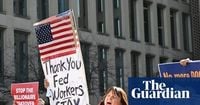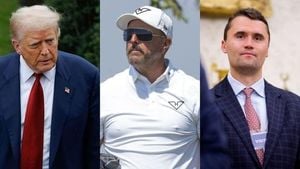On September 1, 2025, the streets of American cities from San Francisco to Chicago pulsed with the chants and footsteps of workers rallying for their rights, as this year’s Labor Day took on a particularly charged atmosphere. For many, the holiday was less about barbecues and parades, and more about protesting what they see as unprecedented attacks on labor protections and union power under President Donald Trump’s second term.
In San Francisco, the day began early. At 9 a.m., members and supporters of The National Active and Retired Federal Employees Association gathered outside the Phillip Burton Federal Building. The crowd included workers from the IRS, the U.S. Postal Service, and other federal agencies. Their message was clear: they were rallying against federal job cuts, threats to unions, and what they described as unwelcome interventions by the Department of Government Efficiency (DOGE) in Social Security and IRS tax returns. Alphonzo Breland, president of the National Treasury Employees Union Chapter 20, summed up the mood, stating, “We still have Trump, still attacking federal employees, and right now he's still trying to shut down agencies. We are also under attack because there are employees who's still trying to hang in there and keep their job, but they are threatening to lose their job.”
This protest was just the first of several in the Bay Area that day, with the San Francisco Labor Council leading a march from the 16th and Mission BART Station to Dolores Park at 11 a.m., drawing in a diverse group of union members and supporters. According to KGO, the sense of urgency among protesters was palpable, with many feeling that this year’s Labor Day was starkly different from those in the past due to the scale and speed of federal actions against labor rights.
Chicago, too, saw a major outpouring of worker solidarity. Hundreds of people representing dozens of unions—including the Chicago Teachers Union, hospitality workers, Teamsters, and healthcare employees—converged in the city’s West Loop for a rally dubbed “Workers Over Billionaires.” The protest aimed to highlight the growing influence of billionaires in politics and to push back against federal cuts instituted by the Trump administration. Mark Petersen, a participant, captured the spirit of the event: “I think solidarity among workers is probably the most important thing we can do right now. We’re looking at our country get disassembled from the top down, and the best thing we can do is unite from the bottom up.”
Organizers didn’t shy away from naming names. Elon Musk and his Department of Government Efficiency, as well as corporations like Target for scaling back Diversity, Equity, and Inclusion (DEI) practices, were singled out for criticism. Randi Weingarten of the American Federation of Teachers delivered a pointed rebuke: “What has happened in this country is that the billionaires don’t understand this country was created in protest and resistance to fight off a king, not to recreate a king.”
While the White House used social media to tout its support for American workers—posting, “For decades, a corrupt political class sold out our workers and shipped away our jobs. On January 20, that ended. Under President Trump, we’re restoring American labor, reviving manufacturing, securing fair trade, and bringing jobs back home—to AMERICAN workers”—many on the ground told a different story. The U.S. Department of Labor called it a “new dawn” and “golden age” for American labor, yet the rally’s participants and labor leaders expressed deep skepticism.
Chicago’s rally also addressed local anxieties. Mayor Brandon Johnson led chants of “No troops in Chicago! Invest in Chicago,” in response to President Trump’s threat to deploy National Guard troops and ICE agents if the city’s crime rates did not improve. The context was grim: over the Labor Day weekend, 53 people were shot and seven killed across the city. Protesters saw the threat of federal intervention as another example of heavy-handed tactics that, in their view, miss the real needs of working people.
Nationally, the Trump administration marked Labor Day by draping a massive banner outside the U.S. Department of Labor. The banner, emblazoned with Trump’s portrait and the phrase “American Workers First,” was meant to signal a pro-worker agenda. Yet, according to The Guardian, labor advocates argue that the administration’s actions tell a different story. They point to dozens of policy moves that they say have made jobs more precarious and less safe, from halting enforcement of regulations protecting miners from lung disease to firing the chair of the National Labor Relations Board, leaving it unable to check illegal anti-union tactics.
Perhaps most consequentially, Trump stripped one million federal workers of their right to bargain collectively, tearing up their union contracts. Liz Shuler, president of the AFL-CIO, called it “a big betrayal,” adding, “We knew it would be bad, but we had no idea how rapidly he would be doing these things. He is stripping away regulations that protect workers. His attacks on unions are coming fast and furious. He talks a good game of being for working people, but he’s doing the absolute opposite.”
The administration also cut staffing at the Occupational Safety and Health Administration (OSHA) by 12% and proposed rolling back safety regulations on construction sites and mines. The move to end minimum wage and overtime protections for 3.7 million home-care and domestic workers particularly alarmed advocates. Jenny Smith, a home-care worker in Illinois, said, “If you take away these wage protections, it will take money out of these workers’ pockets. The majority of these workers are Black, brown and single mothers. You’re taking from their children’s mouths.”
While the Trump administration insists that its policies are reviving American manufacturing and boosting blue-collar wages, critics argue that the benefits are uneven at best. Economic experts warn that aggressive deportation policies could result in a net loss of nearly 6 million jobs over four years, as both immigrant and native-born workers are affected. Tariffs, too, have slowed economic growth and pushed up prices, impacting everyone from airport cargo handlers to grocery shoppers. As Corey Mahoney, a cargo handler at JFK airport, put it, “The tariff situation has slowed down work, and many people lost their jobs.”
Union leaders and labor experts compare Trump’s record unfavorably even to Ronald Reagan’s, long considered the most anti-union president of modern times. Julie Su, who served as acting labor secretary under President Biden, said, “This president wants to make America non-union again. He’s certainly trying to make the government non-union again.”
Amid all this, labor groups are not backing down. The AFL-CIO alone planned nearly 1,000 rallies and events across the country this Labor Day, launching what they describe as a year of mobilization. As Shuler declared, “The state of working people in this country is they’re under attack.”
For many Americans, this Labor Day was a stark reminder that the fight for workers’ rights is far from over. The rallies, the speeches, and the personal stories all point to a nation wrestling with its identity—caught between promises of prosperity and the lived reality of its working class.




